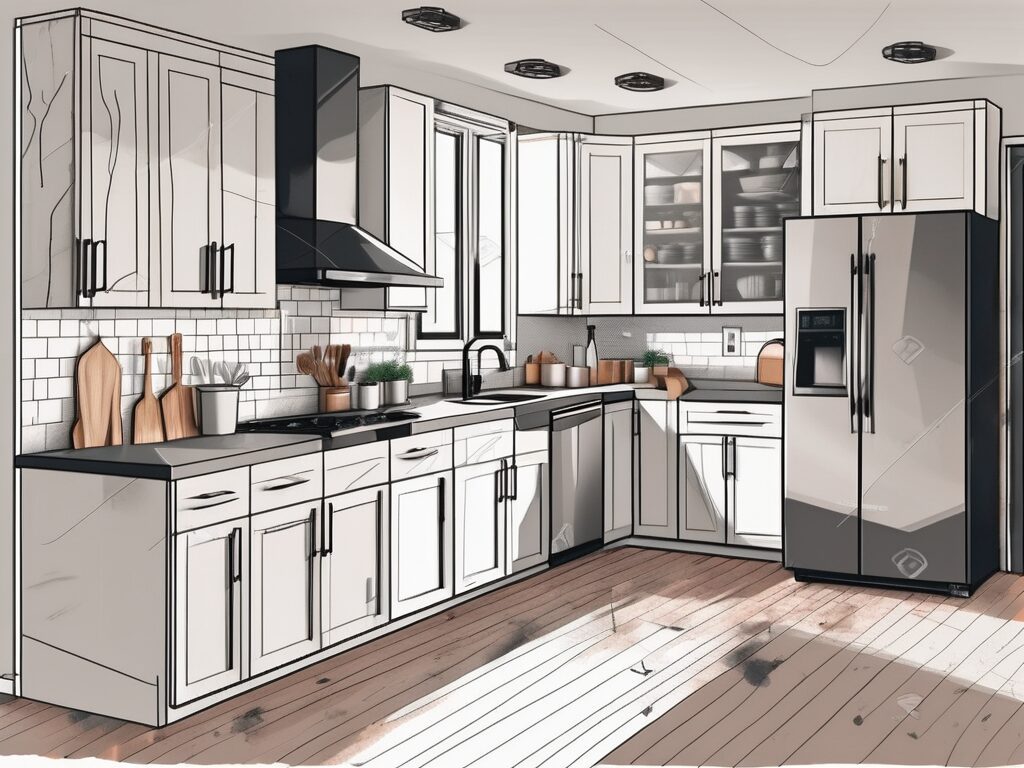
Agent A-Team or Solo Superhero? Finding the Right Real Estate Partner for Your Selling Journey in Wildwood Florida
When it comes to selling your home in Wildwood, Florida,…
January 29, 2024
Are you planning to upgrade your kitchen in 2024? One crucial aspect to consider is the cost of installing new kitchen cabinets. Understanding the expenses involved can help you budget appropriately and make informed decisions. In this ultimate guide, we will break down the various factors that contribute to kitchen cabinet installation costs in 2024, providing you with essential information for your renovation project.
When it comes to installing kitchen cabinets in 2024, the expenses can vary significantly based on several factors. Understanding these factors can give you a better idea of what to expect in terms of costs.
One of the main factors that can affect the cost of installing kitchen cabinets is the type of cabinets you choose. There are various options available in the market, ranging from stock cabinets to custom-made ones. Stock cabinets are pre-made and come in standard sizes, making them more affordable compared to custom cabinets.
Another factor to consider is the size of your kitchen. Larger kitchens may require more cabinets, which can increase the overall cost of installation. Additionally, the layout of your kitchen can also impact the complexity of the installation process, potentially affecting the labor costs involved.
The installation costs of kitchen cabinets in 2024 can be divided into various components. Let’s take a closer look at each of these factors:
1. Cabinet Materials: The type of material you choose for your cabinets can significantly impact the cost. Common materials include solid wood, plywood, particleboard, and MDF. Each material has its own price range, with solid wood being the most expensive and particleboard being the most affordable.
2. Cabinet Style and Design: Cabinets come in various styles and designs, such as shaker, flat-panel, or raised-panel. More intricate designs and details can increase the cost of both the cabinets and the installation.
3. Hardware and Finishes: The cost of hardware, such as handles, knobs, and hinges, should also be considered. Additionally, the type of finish you choose, such as stained, painted, or laminated, can affect the overall cost.
4. Labor Costs: Hiring professional contractors for the installation is a common choice for many homeowners. The labor costs can vary depending on the complexity of the installation, the location, and the contractor’s experience and reputation.
5. Additional Expenses: Apart from the cabinet and labor costs, there may be additional expenses involved in the installation process. This can include demolition, plumbing, electrical work, or any modifications required to accommodate the new cabinets.
To put things into perspective, let’s consider a real-life example of kitchen cabinet installation. Sally, a homeowner on a moderate budget, recently renovated her kitchen. She opted for mid-range custom cabinets and hired professional contractors for the installation. Here is a breakdown of her expenses:
Materials: Sally spent $4,000 on custom cabinets, including hardware and finishes. She chose solid wood cabinets with a stained finish, giving her kitchen a warm and elegant look.
Labor: The professional installation team charged $2,500 for their services. They ensured precise measurements, proper alignment, and a seamless installation, resulting in a high-quality finish.
Additional Costs: Sally also incurred $1,200 in additional expenses, such as demolition, plumbing, and electrical work required during the installation process. This included removing the old cabinets, rerouting some plumbing lines, and installing new electrical outlets.
Based on this example, Sally’s total kitchen cabinet installation cost amounted to $7,700. It’s important to note that this cost can vary depending on individual preferences, geographical location, and other unique factors.
When it comes to renovating your kitchen, one of the most important factors to consider is the cost of installing kitchen cabinets. However, it’s not just the price of the cabinets themselves that you need to take into account. Inflation plays a significant role in determining the overall cost of the installation process in 2024.
So, how exactly does inflation impact the cost of installing kitchen cabinets? Well, it’s quite simple. When inflation rises, the prices of materials, labor, and other essential elements of the installation process also increase. This means that you can expect to pay more for everything involved in the installation, from the cabinets themselves to the tools and equipment needed to complete the job.
For example, let’s say you’re planning to install custom-made kitchen cabinets in your home. The cost of the materials needed for these cabinets, such as wood, hardware, and finishes, will likely increase due to inflation. Additionally, the labor costs associated with the installation will also be higher, as contractors and tradespeople will need to adjust their prices to account for the rising cost of living.
It’s important to note that the inflation premium for 2024 is expected to be around 5%. This means that you should factor in this additional cost when budgeting for your kitchen renovation. By doing so, you can avoid any unpleasant surprises and ensure that you have enough funds to cover the increased expenses.
Another aspect to consider is the impact of inflation on the availability of materials. When inflation rises, the demand for certain materials may also increase, leading to potential shortages. This could result in delays in the installation process or even higher prices if you need to source materials from alternative suppliers.
Furthermore, inflation can also affect the cost of other related services, such as plumbing and electrical work. If these services are required as part of your kitchen cabinet installation, you may need to account for potential price increases in these areas as well.
Overall, understanding the inflation premium for 2024 is crucial when it comes to budgeting for your kitchen cabinet installation. By being aware of the potential impact of inflation on material prices, labor costs, and other related services, you can ensure that you are prepared and able to complete your renovation project without any financial setbacks.
The size of your kitchen directly influences the overall cost of cabinet installation. Larger kitchens require more materials, more labor, and often more complex installation processes. Additionally, larger kitchens may also need additional cabinets, resulting in increased costs. It’s important to keep this in mind when estimating your budget.
When it comes to cabinet installation, the size of your kitchen plays a crucial role in determining the final cost. A larger kitchen means more square footage to cover with cabinets, which translates to higher material costs. Not only do you need more cabinets to fill the space, but you also need more hardware, such as hinges and handles, to complete the installation.
Moreover, the labor required for installing cabinets in a larger kitchen is significantly more time-consuming and intricate. Professional installers need to carefully measure and align each cabinet to ensure a seamless fit. In larger kitchens, this process becomes more complex due to the increased number of cabinets and the need for precise measurements. This additional labor translates to higher costs.
Another factor to consider is the layout of your kitchen. Larger kitchens often have more intricate layouts, with additional features like islands, breakfast bars, or built-in appliances. These elements require specialized installation techniques, which can further drive up the cost. Additionally, the larger the kitchen, the more time it takes to complete the installation, resulting in increased labor costs.
Furthermore, larger kitchens may require additional cabinets to maintain a balanced and aesthetically pleasing design. If your kitchen is spacious, you may need extra cabinets to fill the empty wall space and create a cohesive look. These additional cabinets not only add to the material costs but also increase the time and effort required for installation.
It’s important to note that while larger kitchens generally come with higher installation costs, they also offer more design possibilities. With a larger space, you have the freedom to incorporate various cabinet styles, finishes, and organizational features. This flexibility allows you to create a truly customized kitchen that suits your needs and preferences.
When estimating the cost of cabinet installation for your kitchen, it’s crucial to take into account the size of your space. Consider the additional materials, labor, and complexity involved in installing cabinets in a larger kitchen. By understanding these factors, you can make an informed decision and ensure that your budget aligns with your desired outcome.
Choosing between stock and custom cabinets is an essential decision that impacts both cost and quality. Stock cabinets, while more affordable, offer limited design options. On the other hand, custom cabinets provide greater flexibility, allowing you to tailor them to your specific needs and preferences. However, they come at a higher price point. Consider your budget, design expectations, and desired durability when deciding which option is right for you.
When it comes to stock cabinets, they are pre-made and readily available in standard sizes. These cabinets are mass-produced, which makes them more cost-effective compared to custom cabinets. Stock cabinets are a popular choice for those who are working within a tight budget or have a shorter timeline for their kitchen renovation project. They are often made from particleboard or plywood, which may not be as durable as the materials used in custom cabinets.
On the other hand, custom cabinets are built to order, allowing you to have complete control over the design and functionality. With custom cabinets, you can choose the materials, finishes, hardware, and even the layout of your kitchen. This level of customization ensures that your cabinets perfectly fit your space and meet your specific storage needs. Custom cabinets are typically made from high-quality materials, such as solid wood, which enhances their durability and longevity.
One of the main advantages of stock cabinets is their affordability. Since they are mass-produced, they are generally priced lower than custom cabinets. This makes them an attractive option for homeowners who want to save money on their kitchen renovation. However, it’s important to note that stock cabinets may not offer the same level of design options as custom cabinets. If you have a specific vision for your kitchen and want unique features, custom cabinets may be the better choice.
Custom cabinets, while more expensive, offer a wide range of design possibilities. You can choose from various styles, finishes, and hardware options to create a kitchen that reflects your personal taste and style. Additionally, custom cabinets can be designed to maximize storage space and functionality, ensuring that every inch of your kitchen is utilized efficiently. If you have a larger budget and want a kitchen that is truly one-of-a-kind, custom cabinets are the way to go.
When deciding between stock and custom cabinets, it’s important to consider your budget, design expectations, and desired durability. Stock cabinets are a cost-effective option that can be readily available, while custom cabinets offer greater flexibility and customization. Ultimately, the choice depends on your individual needs and preferences. Whether you choose stock or custom cabinets, investing in quality cabinetry will enhance the overall look and functionality of your kitchen.
The labor cost is another significant component when estimating the cost of kitchen cabinet installation. Professional installers typically charge based on the complexity of the job, time required, and their level of expertise. On average, labor costs range from $50 to $100 per hour. However, keep in mind that additional charges for services like removing old cabinets or dealing with unexpected obstacles may apply.
When it comes to kitchen cabinet installation, hiring a professional can save you time and ensure a high-quality result. The labor cost is determined by various factors, including the size of your kitchen, the number of cabinets to be installed, and the intricacy of the design. A skilled installer will assess these factors and provide you with an estimate based on their expertise and experience.
It is important to note that labor costs can vary depending on your location and the availability of skilled installers in your area. In areas with a higher cost of living, you can expect labor costs to be on the higher end of the spectrum. Additionally, if you live in a remote area where skilled installers are scarce, you may have to pay a premium for their services.
When budgeting for kitchen cabinet installation, it is crucial to consider any additional services that may be required. For instance, if you are replacing old cabinets, the installer may charge extra for the removal and disposal of the old units. Similarly, if your kitchen has unique features or structural challenges, such as uneven walls or plumbing obstacles, the installer may need to spend more time and effort to ensure a proper installation, which can result in higher labor costs.
Another factor that can impact labor costs is the type of cabinets you choose. Some cabinet designs may require more intricate installation techniques or additional hardware, which can increase the time and effort required. It is important to discuss these details with your installer and factor them into your budget to avoid any surprises.
When hiring a professional installer, it is recommended to obtain multiple quotes to compare prices and services. This will give you a better understanding of the average labor costs in your area and help you make an informed decision. Additionally, don’t forget to check the credentials and reviews of the installers you are considering to ensure they have the necessary skills and expertise to handle your project.
While calculating the upfront costs of installing new kitchen cabinets, it is essential to account for any additional expenses that may arise. These hidden costs can include disposing of old cabinets, repairing or replacing damaged walls or floors, or unexpected issues that arise during the installation process. Set aside a contingency budget to deal with unexpected situations, ensuring a smooth and stress-free installation.
One of the hidden expenses that homeowners often overlook when installing new kitchen cabinets is the cost of disposing of the old cabinets. While it may seem like a simple task, it can actually be quite expensive. Depending on your location, you may need to hire a professional junk removal service or rent a dumpster to properly dispose of the old cabinets. This additional cost should be factored into your budget to avoid any surprises.
In addition to the cost of disposing of the old cabinets, you may also need to consider the cost of repairing or replacing damaged walls or floors. During the cabinet installation process, it is not uncommon for walls or floors to get damaged. Whether it’s a small hole in the drywall or a scratched hardwood floor, these repairs can add up quickly. It is important to assess the condition of your walls and floors before starting the installation and budget for any necessary repairs.
Furthermore, unexpected issues can arise during the cabinet installation process, leading to additional costs. For example, you may discover plumbing or electrical problems that need to be addressed before the cabinets can be installed. These issues can range from minor fixes to major repairs, depending on the extent of the problem. It is crucial to have a contingency budget in place to cover any unexpected expenses that may arise.
When planning for the installation of new kitchen cabinets, it is important to consider all the potential hidden costs. By accounting for the cost of disposing of old cabinets, repairing or replacing damaged walls or floors, and unexpected issues that may arise, you can ensure that your budget is comprehensive and accurate. Taking the time to plan and budget for these additional expenses will help you avoid any financial surprises and ensure a successful cabinet installation.
Deciding whether to install new kitchen cabinets ultimately depends on your unique circumstances and goals. New cabinets not only enhance the aesthetic appeal of your kitchen but also improve functionality and storage space. Additionally, updated cabinets can increase the overall value of your home. However, it’s essential to balance the costs against the benefits and consider the potential disruption during the installation process.
In conclusion, understanding the cost of kitchen cabinet installation in 2024 is crucial for planning a successful kitchen renovation. By considering factors such as materials, labor, kitchen size, stock vs. custom options, and hidden expenses, you can make informed decisions and budget accordingly. Remember to seek professional help and gather multiple quotes to ensure the best outcome for your kitchen transformation.

If you want the Richr team to help you save thousands on your home just book a call.
 Book a call
Book a call